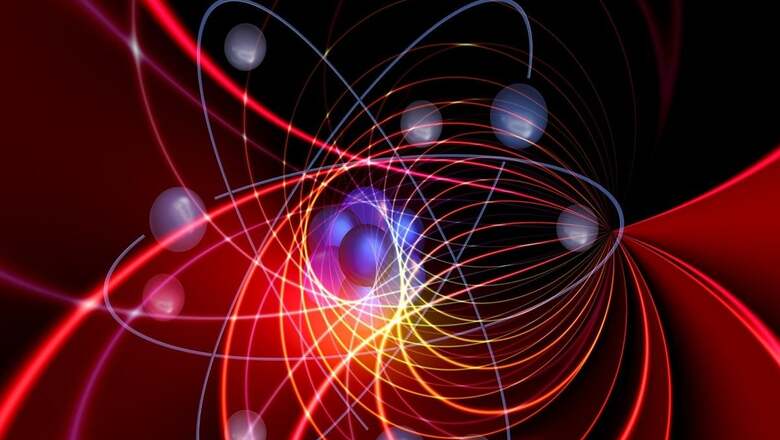
views
Hinduism is the only spiritual tradition which accurately estimates the age of the universe as per modern science. Sanatana Dharma is also an intellectual and multi-cultural tradition attached to sophisticated schools of philosophy, its own system of medicine and psychology, architecture, astronomy, cosmology, metaphysics, metrology, mathematics, and various art forms. Sacred geometry, trigonometry, calculus, the concept of zero and negative numerals, the decimal system, pi, sine and cosine, the idea of multiple big bangs and an inter-dimensional multiverse, can all be traced back to the great minds of Vedic sages.
The very notion of this relationship was unknown and laughable to many in the scientific communities of the West. It was even unknown and laughable to many Indian scientists during and after the colonial rule. It wasn’t until 1989 and 1993, when author Deepak Chopra’s books, ‘Quantum Healing’ and ‘Ageless Body, Timeless Mind’ became popular that the idea that any religion could have much of anything to do with the field of modern science was at all acceptable in any level of academia.
Even karma and reincarnation, the basics of Hinduism, are scientific. As many ways as karma, literally meaning ‘action’ can take place, is fundamental physics. Every action has a certain reaction, no matter if we comprehend it or not. No matter our particular belief system, every cause has an effect. This is true with astronomy, physics, biology, psychology, and neuroscience. Reincarnation: All of nature is a part of an observable cycle that returns to itself upon its death where growth begins again, and we are a part of that nature and growth. Part of that cycle.
The ideas we see in quantum physics are not new, however. Some are indeed many thousands of years old, stemming from elemental darshana (philosophy). The concepts that thought has mass, and that the universe would be static and contain no life without universal intelligence and consciousness, originated in Bharat or ancient India. The idea of time having mass or being made up of what modern physics call chronon, did as well. As did the idea that gravity and time relate.
Modern-day physics has discovered that inert subatomic particles are latent until they are exposed to human thought and intention. These particles come alive or active when awareness is applied. The idea that thought controls matter, and that matter is a crystallisation of thought, can be found in the Samkhyakarika and other Hindu shastra(s) (scriptures).
The very nature of Hindu worship is scientific. Yoga or union between the atma (divine self) and the murti or embodiment of the divine, mirrors the idea of connected consciousness. It mirrors the idea of one animate or inanimate thing, being affected by the mere intention of the worshipper. When the worshipper offers a flower to the murti, he/she says ‘swaha’, meaning ‘what is being offered’ and ‘swadha’ which is the intention behind the offering. Even the Sanskrit word for ‘worship’ is ‘upasana’, which does not mean to glorify the deity, but to simply sit or be near the deity.
As with the quantum principle of one thing being affected by another’s thoughts, proximity counts while the vastness of creation is recognised in the quantum idea of a multiverse. This is a reflection of the Vedic idea of fourteen realms of the universe called ‘lokas’.
“When something vibrates, the electrons of the entire universe resonate with it. Everything is connected. The greatest tragedy of human existence is the illusion of separateness.” ~ Einstein
The ’60s saw the advent of the String theory. This postulates that particles are not singular points but that what we perceive as such, are actually vibrations in loops of strings. Each with its own characteristics or frequencies. In Vedanta, everything in the universe is seen as interconnected, just as our arms and legs are connected to the rest of the body. In quantum mechanics, there is no respite or gap between the observer and the observed. Particles are described as existing in a state of entanglement, where the behaviour of one particle is dependent on the behaviour of another, even if large distances separate them.
“The Brahman forms everything that is living or non-living … the wise man knows that all beings are identical with his self, and his self is the self of all beings.” ~ Isha Upanishad
In Vedanta, the space throughout our universe is multidimensional. There are 64 foremost dimensions. Each is divided into multiple sub-dimensions. We on Earth can only experience three dimensions. Our senses simply do not have the means to experience other aspects of universal reality. Within quantum mechanics, we can find similar ideas.
Physicists speak of reality in terms of particles and waves. What the Vedas call Paramanu, literally meaning ‘universal atom’ and vrittis, literally meaning ‘mind waves.’
Thousands of years ago, the Himalayan rishis recognised that human awareness could only focus on one point of interest at a time and that what we perceive as reality was an illusory maya. A literal parody of reality and truth. The wheel of film being displayed on a movie screen shows one frame at a time. However, those watching the film see a menagerie of frames being projected that seems to be real when shown in sequence, over time and space. Both Vedanta and theoretical physics postulate that we are all matter under mind, or in a sense, dreaming we are awake. Both recognise that what the religious might call ‘God’ and what the physicist might call ‘unified theory’, are nothing but the observer’s consciousness and/or a conscious observer experiencing itself.
String theory is a framework which brings together gravity and quantum mechanics to build a theory of quantum gravity relating to time and space. The Vedantins recognised a force that keeps objects from floating off the surface of the Earth (gravity), 7,000 years before Isaac Newton was born.
The great thinkers of ancient Bharat spoke of how energy and matter at atomic levels, could influence one another from long distances. This is now called Quantum Entanglement. They also claimed that thought has mass and that thought or intention can affect subtle matter and energy. They claimed that the observer affects the observed. Thousands of years later, physicists called this the Observer Effect.
Modern physics uses different terms and language than the rishis did, but they both were drawn to similar theories and conclusions. One explains it with mathematical equations, and the other explains it philosophically. One speaks of reality in an outward and material sense while the other speaks more of inner space and spiritual metaphysics.
The Vedas say that time is eternal and omnipresent. Quantum physics says time is indestructible and controls all motion. The Hindu Dharma recognises Brahman, not as ‘God’, but as a principle of an absolute, interconnected reality. The microcosmic and macrocosmic are but reflections of one another. Hindus believe that each individual being is a microcosm or the universal macrocosm. Modern physicists call this ‘superposition’. In Hinduism, this notion can be found in the mantra ‘Aham Brahmasmi’ or even in the greeting ‘namaste.’ Both adhere to the idea that we are all models of the universal reality and the reality of the universe; and that on a more spiritual level, the Atma and Brahman are indeed one being in consciousness. So, it is no wonder so many well-known Western physicists were and are, highly impressed and influenced by the Vedas, Upanishads, and the Bhagavad Gita.
“Most of my ideas are heavily influenced by Vedanta. Multiplicity is only apparent. This is the doctrine of the Upanishads. From the early Upanishads, the recognition ‘Atman=Brahman’ (the self equals the omnipresent) represents the deepest quintessence and insights into the happenings of the world. The total number of minds in the universe is one. In fact, consciousness is a singularity phasing within all beings. There is no kind of framework within which we can find consciousness in the plural. This is simply something we construct because of the temporal plurality of individuals, but it is a false construction. The only solution to this conflict lies within the ancient wisdom of the Upanishads.” ~ Erwin Schrodinger, Nobel Prize-winning physicist.
“After the conversations about Indian philosophy (w/ Rabindranath Tagore), some of the ideas of quantum physics that had seemed so crazy, suddenly made sense. Quantum theory will not look ridiculous to people who have read Vedanta.” ~Werner Heisenberg, German Nobel Prize-winning physicist.
“The general notions about human understanding…illustrated by discoveries in atomic physics…are not unheard of or new. They have a history in Hindu thought. What we shall find in modern physics is a refinement of old wisdom. Access to the Vedas is the greatest privilege this century may claim over all other centuries.” ~ Robert Oppenheimer
“The Hindu religion is the only one of the world’s…dedicated to the idea that the cosmos itself undergoes an immense and innate number of deaths and rebirths. It is the only religion in which the time scales correspond, to those of modern scientific cosmology. Its cycles run from our ordinary day and night to a day and night of Brahma 8.64 billion years long. Longer than the age of the Earth or the Sun, and about half the time since the Big Bang. And they have much longer time scales too.” ~ Carl Sagan
“All perceptible matter comes from a primary substance…filling all space, the Akasha which is acted upon by the life-giving Prana or creative force, calling into existence in never-ending cycles, all things and phenomena.” ~ Nikola Tesla
“Modern physics has shown that the rhythm of creation and destruction is not only manifest in the turn of the seasons and in the birth and death of living creatures, but is also the very essence of inorganic matter. For modern physicists…Shiva’s dance is the dance of subatomic matter.” ~ Fritjof Capra, physicist and director of the Center for Ecoliteracy.
Sean Bradrick is an American Sanatani & Yogi. Author of the soon-to-be-released book, ‘A Hindu’s Guide to Advocacy and Activism’. Views expressed in the above piece are personal and solely that of the author. They do not necessarily reflect News18’s views.


















Comments
0 comment